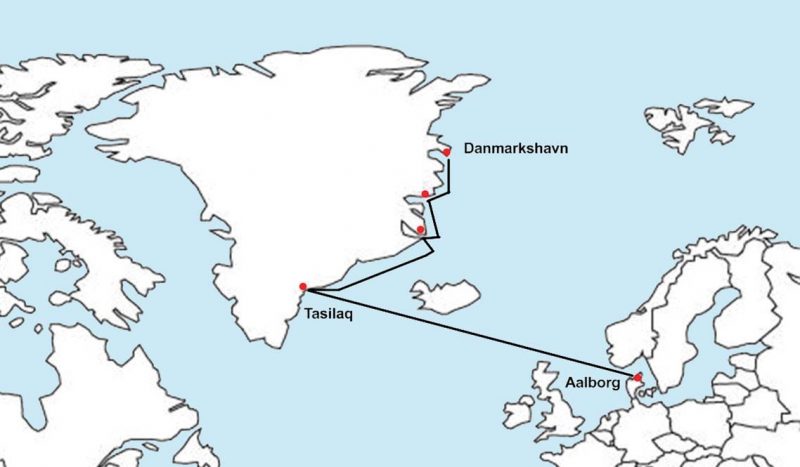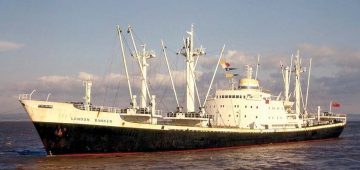In 1998, the stevedore company Arctic Container Operation loaded the polar ship Kista Arctica with supplies for east and northeast Greenland. It was Saturday afternoon 18th July 1998 when we left Grøndlandshavnen in Aalborg, Denmark, with the airfield Kulusuk in southeast Greenland as our first port of call.
The voyage from Aalborg to Kulusuk progressed under relatively calm wind and weather conditions, and Kista Arctica entered anchorage at Kulusuk on Thursday 23rd July in calm weather. Immediately on arrival, the barges were loaded by the ship’s crew and then towed through the ice right up to the quay using the ship’s own little tug. Next day, the anchor was hauled home when ice prevented further unloading, and the journey continued towards Tasilaq. In east Greenland, Tasilaq is the only place where Kista Arctica can reach the wharf to unload supplies, and this means the cargo and containers are unloaded from both ship’s hatches. Unit cargo is unloaded via the side gates.
Saturday 25th July at 1700 the ship was back and anchored at Kulusuk again. The ice conditions had improved and the remaining cargo was unloaded overnight. The voyage continued with the ship’s helicopter used for reconnaissance when conditions were foggy.
In Scoresbysund on Wednesday 29th July the cargo was unloaded by barge. However, the large ice floes had to be pushed away by two small tugs. Cargo was dragged on to a submerged steel pontoon at the barge unloading site and then carried by forklift to the warehouse.
Kista Arctica entered Constable Point on Friday 31st July and this time there was 90 per cent winter ice coverage at the anchorage on arrival. The ship was held in the ice, and it was impossible to tow the barge with supplies to the quay. Therefore, “Operation Helicopter Slinging” began. The ship’s crew had to separate the cargo into smaller pieces as the helicopter could sling a maximum of 500kg out to the airfield. In the evening, however, the crew managed to unload the 12 tonne fire truck we brought into the aerodrome’s own barge which was then towed to shore.
An unfortunate thing happened. The engine in the little tug we carried broke down, and because of the heavy ice at the anchorage, it was hard to put the vessel’s lifeboat in the water to retrieve the wrecked tug. The ship’s helicopter pilot showed considerable resourcefulness as he flew over the wrecked tug with a long strap that the tug’s crew tied on. The pilot then dragged the towed boat by helicopter to Kista Arctica. It was very fascinating and also very courageously done.
On this journey, Kista Arctica participated in a pioneering ice chart project. The Danish weather bureau (DMI) prepared special ice maps for us based on Radarsat data we sent them. These were faxed back to the ship after being tailored to the ship’s specific needs on the voyage.
Kista Arctica arrived at Daneborg Wednesday 6th August and we used the helicopter to sling 200 litre drums of jet fuel to shore. The operation was completed without problems, and then it was time to begin loading the Sirius Patrol’s barges. Sirius Patrol is an elite Danish naval unit that conducts long-range reconnaissance patrols and enforces Danish sovereignty in the Arctic wilderness of north and east Greenland.

People from the outpost drove a wagon onto a barge and then sailed the barge to the ship using a conventional outboard motor. The barge was moored alongside, and supplies were loaded directly in to the farm wagon. The barge then sailed back to shore and the farm wagon could be driven straight to the patrol’s depot. It was simple and very efficient.
After a night of calm weather, a strong gale blew up from the north (force 7 to 8 Beaufort). This meant that by mid-afternoon we had to stop loading the barges due to heavy seas. There was a thick fog overnight, but by 0700 it had cleared up so much that the barge unloading site could again be seen a few hundred metres away. The loading of return cargo began under relatively calm wind and weather conditions, but in the afternoon a several hundred metre ice floe drifted towards the anchorage. The pressure on the ship was so violent that the main engine was started up and the anchor salvaged. The rest of the loading was done under quite difficult circumstances, but shortly before 1800 the ship was loaded.

The Kista Arctica departed from Danmarkshavn on Friday 13th August at 1100 headed for Ella Island in the south. We sailed close to Store Koldewey, Shannon Island, Lille Pendulum, Clavering Island and Kap Broer Ruys in light ice conditions. At Kap Broer Ruys, the ship met hard polar ice. The winter had not yet gone. After a helicopter ice reconnaissance, the ship’s first mate could confirm the information in the ice charts from that day provided by DMI.
We were waiting for improvement in the ice situation when suddenly, and without warning, the wind blew up sharply from the north. There was very strong ice pressure on the ship which had a heel of 5 degrees starboard as a result. Furthermore, there was incipient formation of new ice in the polar ice and frequent occurrences of dense fog.
The situation was critical. Ballast water was pumped into one of the large ballast tanks on the starboard side to correct the list from the ice pressure. Later when the ice pressure was suddenly relieved, the ship almost toppled just as suddenly to starboard. This was fairly quickly corrected, so the ship was on the mend.
On the trip, I wrote a little ‘newspaper’ called Kista Arctica News each day for the ship’s crew. When we were stuck in pack ice, Rune, the ship’s assistant, drew a cartoon for the news. It showed the captain down by the ship’s helicopter deck asking the pilot if it was possible to make a reconnaissance trip. The captain is drawn with a gun in his back pocket. We always took a loaded gun with us in the helicopter in case we had to make an emergency landing somewhere where polar bears were about.
During the trip down to Kulusuk through icy waters, there was a lot of fog again, and it was now dark at night. The ship’s powerful ice spotlights were used to light up the front of the ship so that it would be a little easier to spot ice visually, although the ship’s radar was also monitored intensively by the ship mates on watch.
The staff at Kulusuk airport had packed two 20 foot flatracks with trash and then loaded them in the airport’s own barge, similar to the barge which was on board Kista Arctica. The small tug from the ship was put into the water to retrieve the aerodrome barge laden with the two heavy flatracks that were to be loaded onto the ship.
Now however fate had it that the barge was leaking, and it had quietly consumed a lot of seawater and on the way out to the ship, 30 metres from the shore, it sank. The barge crew was quick to rescue themselves by climbing on board the little tug. The tug driver, chief mate on our ship, exclaimed: “Damn, now I will be on the front cover of Kista Arctica News”, which indeed happened. It was a cover story with clear parallels to the Titanic disaster.
From Kulusuk to the North Sea we had calm weather, but in the North Sea the wind came up and we had a sustained heavy northerly swell. We had to run with the weather, but on Saturday 29th August 1998 Kista Arctica was back in Grøndlandshavnen. We were ready to load new supplies and destined again for the northeast of Greenland.
Epilogue
During this stay in Grønlandshavnen, before departing on the next trip, the ship took on bunkers. The bunkering was performed by the ship’s engine crew, and along the way the engineer on duty kept a close eye on the ship’s draft forward and aft. As he went to read the ship’s draft at the helm, he discovered that many of the bolts that tightened the rudder to the rudder stock had come loose.
This had very likely occurred during the forced sailing of the ship when we had to get free from the granite-hard polar pack ice near Kap Broer Ruys. Losing the ship’s rudder while sailing in the east Greenland polar ice was just about the only drama we missed out on.
It was an experience we could certainly do without no matter how good a headline it would have made for Kista Arctica News.


Comments
Sorry, comments are closed for this item